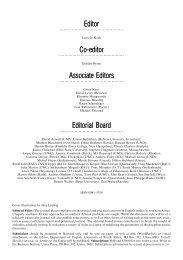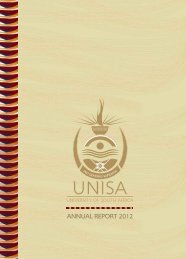Download the Annual report 2011 - Unisa
Download the Annual report 2011 - Unisa
Download the Annual report 2011 - Unisa
You also want an ePaper? Increase the reach of your titles
YUMPU automatically turns print PDFs into web optimized ePapers that Google loves.
UNISA ANNUAL REPORT <strong>2011</strong><br />
REPORT ON INTERNAL<br />
ADMINISTRATIVE CONTROLS<br />
<strong>Unisa</strong> uses internal administrative controls to provide reasonable assurance that <strong>the</strong> following<br />
activities are accomplished:<br />
• <strong>the</strong> university’s objectives are achieved on an effective, efficient, economical, socially responsible<br />
and ethical basis<br />
• financial <strong>report</strong>ing is accurate, timely and in accordance with financial <strong>report</strong>ing standards;<br />
• assets and information are safeguarded<br />
• quality is improved<br />
• legislation and regulations are complied with<br />
• <strong>the</strong> ethical culture is infused into <strong>the</strong> operational activities of employees.<br />
The existing internal administrative controls are directive, detective and corrective and include<br />
policies, procedures and standard business forms; defined structures, roles, responsibilities and<br />
segregation of duties; and delegation of authority and signing powers, accountability processes<br />
and system controls.<br />
All policies are compiled and/or revised through a due diligence process and approved at Council<br />
level. The due diligence process gives some level of assurance pertaining to <strong>the</strong> probity and compliance<br />
with institutional standards. Business forms have been incrementally standardised to assist<br />
employees in <strong>the</strong>ir day-to-day activities, structures have been revised and approved, and roles<br />
and responsibilities are defined as reflected in <strong>the</strong> structures. The segregation of duties is established<br />
through <strong>the</strong> aforementioned structures and responsibilities. The delegation of authority<br />
and signing powers is designed to mitigate <strong>the</strong> risk of unauthorised transactions and accountability<br />
processes, as well as labour relations operations such as internal disciplinary and grievance<br />
processes.<br />
Systems are widely used in <strong>the</strong> university and system controls are in place to secure <strong>the</strong> systems<br />
control over <strong>the</strong> input, processing and output of information. This receives attention<br />
during <strong>the</strong> systems design phase, and improvements for input, processing and output controls<br />
are continuously assessed through internal and external assurance reviews. Back-ups of data<br />
are made and a disaster recovery plan is available for <strong>the</strong> university. Fortunately <strong>Unisa</strong> has<br />
not had to put <strong>the</strong> efficacy of <strong>the</strong> plans and systems to <strong>the</strong> test. Information communication<br />
and technology standards are in <strong>the</strong> process of being embedded into <strong>the</strong> systems and<br />
ICT is aligned to <strong>the</strong> university’s objectives with an ever-increasing focus on service delivery,<br />
support and control over processes and data.<br />
The determination of strategic and operational objectives is based on an established<br />
and proven planning methodology and is inclusive of risk management practices.<br />
The planning process has commenced with a dedicated focus on identification of<br />
<strong>the</strong> risks associated with <strong>the</strong> planned objectives as well as <strong>the</strong> appropriate mitigation<br />
strategies to address <strong>the</strong> risks.<br />
| 53 |

















